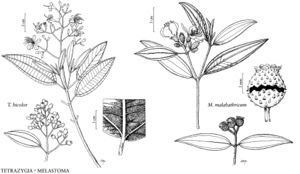Melastoma malabathricum
Sp. Pl. 1: 390. 1753. (as malabathrica)
Shrubs or trees 0.5–2(–3) m; branchlets with dense, short, appressed scales. Leaves persistent; petiole 0.5–1.9 cm; blade usually lanceolate to elliptic-lanceolate, rarely narrowly lanceolate to oblong, 4–15 cm × 20–50 mm, base rounded to subcordate, apex acuminate, surfaces densely strigose to strigose-sericeous. Inflorescences: (1 or)2–7-flowered, compact or loose; bracts 2, leaflike from base. Pedicels 2–8(–10) mm, strigose. Flowers: hypanthium 5–9 mm, densely appressed-scaly; calyx 5–13 mm; petals obovate, 25–35(–40) mm; ovary ovoid. Fruits broadly urceolate, 5–12 mm, succulent, pinkish tan, densely appressed-scaly, rupturing irregularly transversely at maturity. Seeds 1 mm diam., densely punctate, imbedded in purplish red, sweet, astringent pulp.
Phenology: Flowering Feb–Apr.
Habitat: Wet flatwoods.
Elevation: 10 m.
Distribution
Introduced; Fla., Asia (Cambodia, India, Japan, Laos, Malaysia, Myanmar, Nepal, Sri Lanka, Thailand, Vietnam), Pacific Islands (Papua New Guinea, Philippines, Taiwan), Australia, introduced also in Mexico, West Indies (Jamaica), Indian Ocean Islands (Mauritius), Pacific Islands (New Zealand).
Discussion
Melastoma malabathricum is known in the flora area from only a single report; a plant apparently naturalized in the middle of wet flatwoods in a park in Palm City (Martin County), collected in March 2000 (voucher USF). In a number of other states, it is explicitly regarded as a potential threat and listed as a noxious weed, even prohibited or quarantined in California, Massachusetts, Minnesota, and Oregon. All species of Melastoma are formally considered noxious in Hawaii. The seeds are bird-dispersed and M. malabathricum in southeast Asia sometimes forms dense thickets in forest plantations, orchards, pastures, rangelands, abandoned clearings, and disturbed sites.
Melastoma malabathricum was regarded by K. Meyer (2001) as the most widespread and morphologically variable species of the genus; he listed 65 synonyms for subsp. malabathricum. Meyer recognized only subsp. normale as distinct in its more densely pilose abaxial leaf surfaces and its pilose branches; intermediates occur and the geographic range of subsp. normale is completely within that of subsp. malabathricum.
Selected References
None.
